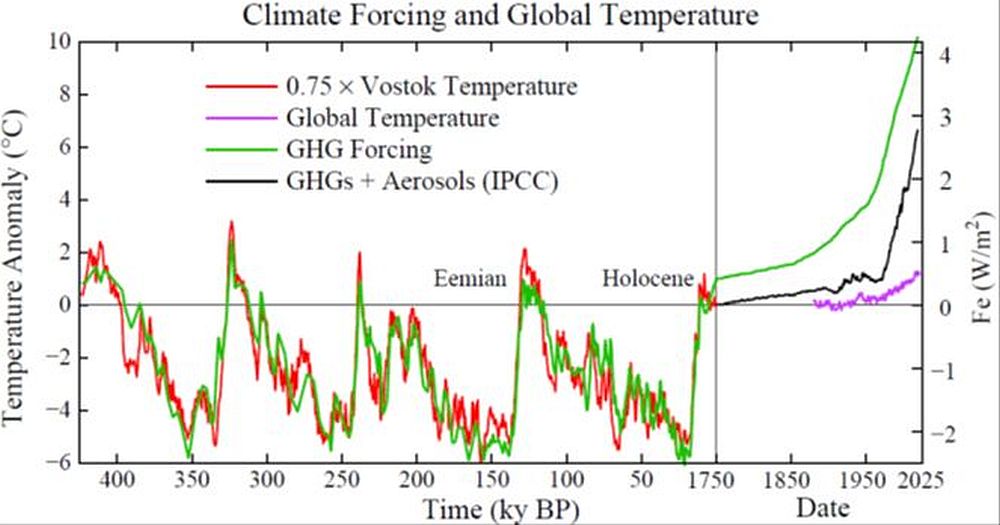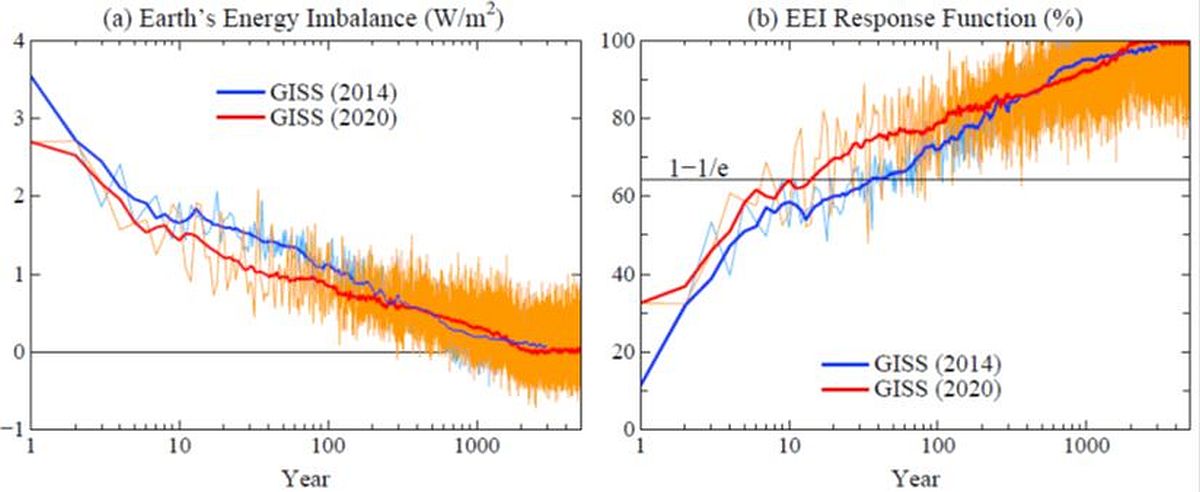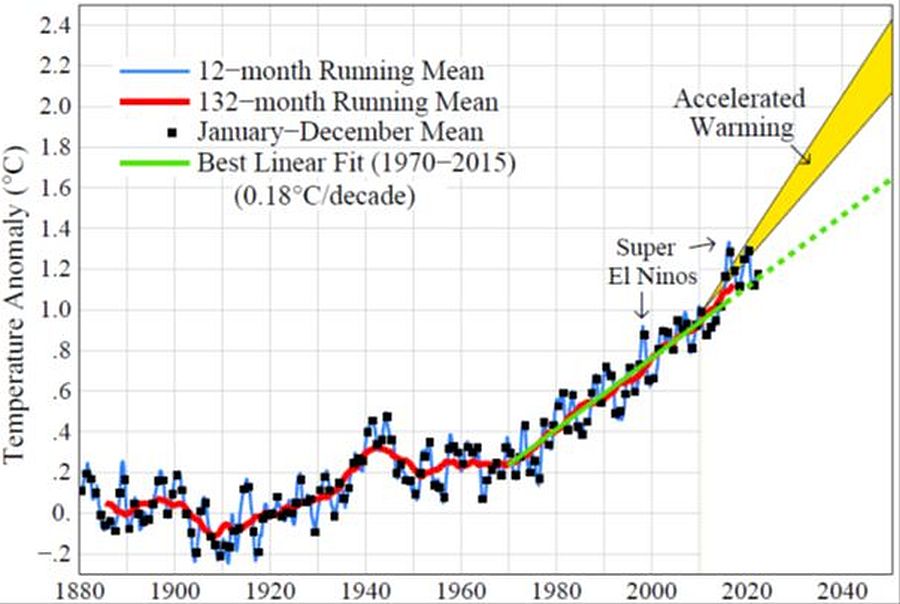|
Global warming sw
Global warming in the pipeline 
Fig. 1. Global surface temperature (left scale) and climate forcings (right scale).
|
|
Global Warming in the Pipeline
13 December 2022
James Hansen and Makiko Sato
|
|
With 14 co-authors, we have submitted Global Warming in the Pipeline[1] to Oxford Open Climate Change. With permission of Editor-in-Chief Eelco Rohling, the submitted version is available on arXiv, the website used by physicists for preprints. One merit of arXiv is that it permits discussion with the scientific community (in addition to official reviewers) analogous to but less formal than the procedure used by journals with a “Discussion” publication phase. Thus, we invite criticism of the submitted paper. We do not invite media discussion; we will write a summary appropriate for the public at the time a final version of the paper is published. This approach allows time to work on a second paper. Also, now that it’s clear what President Biden is willing to do (and not do) about climate change, it’s time for JEH to finally finish Sophie’s Planet.
We were spurred to write this paper in part by papers of Tierney et al.[2] and Seltzer et al.,[3] which made a persuasive case that global temperature during the Last Glacial Maximum (LGM, ~20,000 years ago) was about 6°C colder than the Holocene. Forty years ago, we realized[4] that the LGM cooling had to be greater than the 3.5°C estimated by the CLIMAP project, because the CLIMAP surface conditions left Earth out of energy balance by 1.6 W/m2 – and that was without realizing that CH4 and N2O were less during the LGM. The CLIMAP boundary conditions left a planet trying to cool off with a (negative) forcing half as large as doubled CO2 (2×CO2) forcing. The Tierney and Seltzer papers resolve the matter: the LGM really was cold.
One implication is that equilibrium climate sensitivity (ECS) is high, at least ~4°C for 2×CO2. That ECS refers to the climate response including only “fast” feedbacks. Human-made greenhouse gas (GHG) climate forcing today is 4 W/m2, equivalent to 2×CO2. Eventual climate response to this forcing, including slow feedbacks, is ~10°C (Fig. 1). Human-made aerosols reduce this to ~6-7°C.
We were initially surprised by the quick decrease of Earth’s energy imbalance (EEI) after CO2 was doubled in climate simulations of the Goddard Institute for Space Studies (GISS) global climate models (GCMs) – [in production of acronyms, we seem to be relentless, merciless]. In the first year after CO2 is doubled, the initial 4 W/m2 forcing is already reduced by one-third in the GISS (2020) model (Fig. 2a). The e-folding time for the global temperature increase is about a century, yet the e-folding time for EEI is as short as a decade for this newer GISS model.
|
|

Fig. 2. (a) Earth’s energy imbalance (EEI) for 2×CO2, and (b) EEI response function.
|
|
This rapid decline of EEI probably signifies a cloud change in response to the radiative forcing, as it is hard to think of anything else that could be responsible for such a large change. In fact, the community was already aware of what we call an “ultrafast feedback,” see reviews by Andrews et al.,[5] Kamae et al.,[6] and Zelinka et al.[7] This rapid tropospheric change can be described as an adjustment, analogous to the stratospheric temperature adjustment that occurs quickly after a CO2 doubling – there are pros and cons as to whether to include the effect in the climate forcing or as a feedback. The important point is not the terminology, but rather implications for climate sensitivity. The high climate sensitivity implied by the paleoclimate data tends to provide support for models that have been finding amplifying cloud feedbacks. It is recognized that the two GISS models in Fig. 2 do not have realistic cloud microphysics and the cloud parameterization in the GISS (2020) model has excessive supercooled water drops in cloudtops (Fig. 1 of Kelley et al.[8]).
Cloud modeling – including the effects of aerosols on clouds – may be spurred by “the great inadvertent aerosol experiment.” Recent regulations on the sulfur content of ship fuels imposed by the International Maritime Organization (IMO) affect injection of human-made cloud condensation nuclei, with a significant effect on absorbed solar radiation. Large human-health effects of aerosols make it likely that recent aerosol reductions will continue and global warming accelerate (Fig. 3).
|
|

Fig. 3. Global surface temperature relative to 1880-1920 mean.
|
|
[1] Hansen, J.E., M. Sato, L. Simons, L.S.Nazarenko, K. von Schuckmann, N.G. Loeb, M.B. Osman, P. Kharecha, Q. Jin, G. Tselioudis, A. Lacis, R. Ruedy, G. Russell, J. Cao and J. LI: Global warming in the pipeline, submitted to Oxford Open Climate Change.
[2] Tierney, J.E., J. Zhu, J. King, S.B. Malevich, G.J. Hakim and C.J. Poulson: Glacial cooling and climate sensitivity revisited, Nature 584, 569-573, 2020.
[3] Seltzer, A.M., J. Ng, W. Aeschbach, R. Kipfer, J.T. Kulongoski, J.P. Severinghaus and M. Stute, Widespread six degrees Celsius cooling on land during the Last Glacial Maximum, Nature 593, 228-232, 2021.
[4] Hansen, J., A. Lacis, D. Rind, G. Russell, P. Stone, I. Fung, R. Ruedy and J. Lerner, Climate sensitivity: analysis of feedback mechanisms, 130-163, in Hansen, J.E., and T. Takahashi (Eds.): Climate Processes and Climate Sensitivity. AGU Geophysical Monograph 29, Maurice Ewing Vol. 5. American Geophysical Union, 368 pp., 1984.
[5] Andrews,T., Gregory, J.M., Forster, P.M., and Webb, M.J.: Cloud adjustment and its role in CO2 radiative forcing and climate sensitivity: a review. Surv. Geophys. 23, 619-635, 2012.
[6] Kamae, Y., M. Watanabe, T. Ogura, M. Yoshimori and H. Shiogama: Rapid adjustments of cloud and hydrological cycle to increasing CO2: a review, Curr. Clim. Chan. Rep 1, 103-113, 2015.
[7] Zelinka, M.D., T.A. Myers, D.T. McCoy, S.Po-Chedley, P.M. Caldwell, P. Ceppi, S.A. Klein and K.E. Taylor, Causes of higher climate sensitivity in CMIP6 models, Geophys. Res. Lett. 47, e2019GL085782, 2020.
[8] Kelley, M., G.A. Schmidt, L. Nazarenko, S.E. Bauer, R. Ruedy, G.L. Russell, et al., GISS-E2.1: Configurations and climatology. J. Adv. Model. Earth Syst., 12, no. 8, e2019MS002025, 2020.
|
|
|


